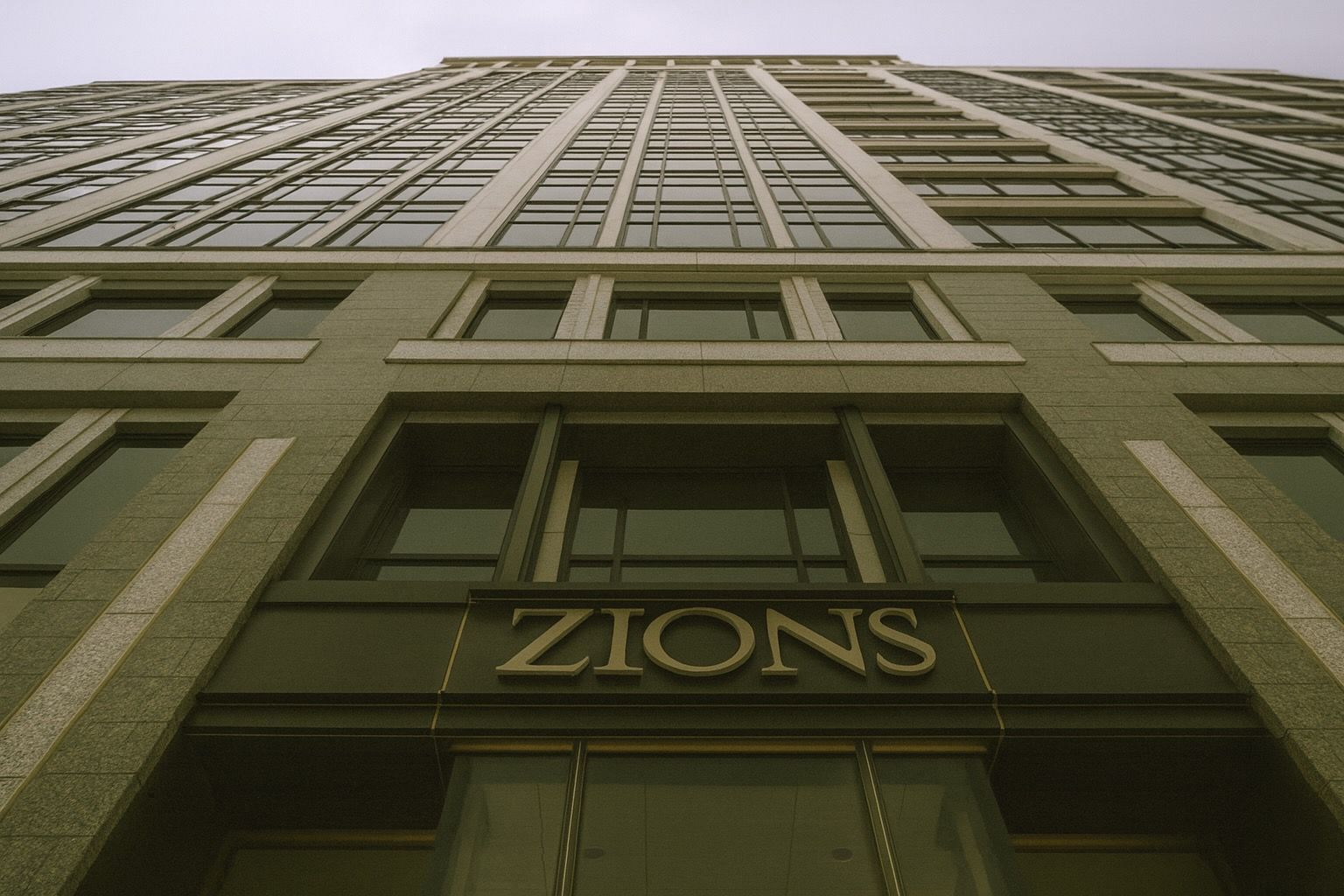- Regional Bank Fraud Shocks: Zions Bancorp stunned investors by disclosing a $50 million loan loss tied to alleged fraud, sending its stock plunging ~13% on Oct. 16 [1]. Western Alliance (which lent to the same borrowers) fell ~11% after revealing its own fraud lawsuit [2]. The back-to-back bad loan revelations – though totaling only tens of millions, not billions – rattled confidence in U.S. regional banks.
- $100B Wiped Out as Panic Sells: The revelations sparked a broader bank stock rout, erasing over $100 billion in market value across 74 U.S. banks in one day [3]. The KBW regional banking index sank ~5–6%, dragging major indexes down – the S&P 500 slid nearly 1%, and the Dow Jones reversed a rally to close almost 400 points lower on Thursday [4]. Even firms with no direct link got hit: Jefferies Financial Group (exposed to a recent auto-lender bankruptcy) tumbled ~10% on contagion fears [5].
- Global Ripple & Safe Havens: Credit jitters quickly went global. Japan’s Nikkei 225 fell ~1.6% and Hong Kong’s Hang Seng ~2% on Friday, followed by Europe’s bank stocks sliding ~2.7% [6]. Major European lenders like Deutsche Bank and Barclays plunged over 5% [7]. Meanwhile investors rushed for safety – gold prices rocketed to an all-time high above $4,370/oz (up ~8% this week) [8], and U.S. Treasury yields plunged to multi-year lows as Fed rate-cut bets grew [9]. The 2-year Treasury yield hit ~3.38% (a three-year low) while the 10-year fell under 4% [10]. Wall Street’s fear gauge (VIX) spiked ~20% to its highest since May, reflecting the sudden risk aversion [11].
- ‘Cockroach’ Credit Fears Emerge: JPMorgan CEO Jamie Dimon warned investors to be prepared for more trouble – “When you see one cockroach, there are probably more,” he said this week after his bank took a $170 million loss on a different bad loan [12]. The “cockroach” analogy resonated as a string of loan blow-ups has surfaced: subprime auto lender Tricolor filed bankruptcy amid fraud claims last month, and auto-parts maker First Brands collapsed owing $10 billion [13]. “It shows you can’t take credit quality for granted, and poor performing credit at one bank can drag down the group quite fast,” noted Argus Research analyst Stephen Biggar [14]. JPMorgan analysts likewise observed that investors tend to “sell first and (ask) questions later” when surprises hit, questioning why so many credit “one-offs” are occurring in quick succession [15].
- Outlook – Volatility vs. Resilience: Bank executives insist these problems are isolated, not systemic. Zions’ management called its $50 million loss “an isolated case” and hired outside investigators to ensure it’s truly a one-off [16]. “Zions faces the challenge of showing this is a one-off and not a broader weakness,” said Zacks analyst Brian Mulberry, ahead of the bank’s Oct. 20 earnings [17]. Western Alliance reports results Oct. 21, and despite recent turmoil, Wall Street remains upbeat – Western Alliance stock is still rated a “Strong Buy” with an average target price ~30% above current levels [18]. Big banks also seem unconcerned: aside from JPMorgan’s precautionary reserve boost, the top five U.S. banks collectively set aside the least loan-loss reserves in two years last quarter [19], signaling they aren’t bracing for a credit apocalypse. Some strategists do warn the market could see another 5–10% pullback as it digests these credit scares [20], but others maintain “the bull market remains intact,” viewing pullbacks as buying opportunities [21]. In short, unless deeper cracks spread, many believe the 2025 economic expansion – and stock rally – “may bend but not break” despite the current jitters [22].
Fraud Shocks at Regional Lenders Ignite a Selloff
This week’s drama began when Zions Bancorporation, a Utah-based regional bank, revealed a major loan fraud that blindsided investors. In an SEC filing on Oct. 15, Zions said it discovered “misrepresentations and contractual defaults” in two large commercial loans (~$60 million total) made by its California Bank & Trust unit [23]. The borrowers – investment funds tied to financiers Andrew Stupin and Gerald Marcil – allegedly used the money to buy distressed mortgages, then shuffled the collateral to other entities, according to Zions’ lawsuit (the borrowers deny the allegations) [24] [25]. Zions moved quickly: it accelerated the loans to default, sued the guarantors, and charged off $50 million, essentially writing the loans down to zero while it pursues recovery [26].
The surprise loss was small in absolute terms (Zions is a ~$90 billion-asset bank), but it was highly unusual – Zions typically makes much smaller business loans, so a $50 million fraudulent loan raised red flags about its underwriting [27]. “The optics of a large C&I loan to a fraudulent borrower from a bank that specializes in small C&I loans is not great,” noted Raymond James analysts, questioning Zions’ risk controls [28]. Investors agreed: ZION stock plunged 12–13% on Oct. 16, its worst one-day drop in six months, wiping out about $600–700 million in market value [29]. The share price sank into the high-$40s – its lowest level in months – erasing a recent rebound and knocking the stock down ~10% for 2025 [30]. An uneventful morning rally on Wall Street abruptly reversed midday as the Zions news hit screens. “Hidden credit stress” is how one Reuters report described the market’s mood [31] – essentially investors wondering if this was just the first cockroach scurrying out of the pantry.
Western Alliance Bancorp, a Phoenix-based peer, quickly became collateral damage. Although Western Alliance had no direct role in Zions’ loans, it revealed it had lent to a related borrower and had already sued that borrower for fraud back in August [32]. In Western Alliance’s case, the borrower allegedly provided fake collateral for a revolving credit line, prompting the bank’s pre-emptive legal action [33]. Western Alliance’s management stressed that its exposure was secured and already identified – noting that its total “criticized” (weak) assets had actually declined since June [34]. That assurance helped WAL stock trim some losses intraday, but it still closed down about 10–11% on Oct. 16 [35]. “The fact another respected regional bank was even tangentially caught up in a fraud scenario shook confidence,” TS2.tech observed in its market analysis [36]. Seeing two banks hit by alleged fraud in the same week put investors on edge about what other surprises might lurk.
Indeed, contagion set in fast. A “sell-first-ask-questions-later” mentality took hold across the banking sector [37]. Any lender perceived as exposed to risky loans or opaque borrowers got slammed. The S&P Regional Bank index plunged ~5.8% that day [38], and over 80% of all S&P 500 stocks fell [39]. Even larger financial players weren’t spared: Jefferies Financial Group, an investment bank that had disclosed hundreds of millions in exposure to the bankrupt First Brands Group, saw its stock tumble ~9–10% as the Zions news stoked “what’s next?” anxiety [40]. “Where there is smoke, there is often fire,” warned IG Markets analyst Tony Sycamore, noting that while the latest bank issues seem contained, the quick fixes that ended 2023’s bank crisis may have left “a tinderbox for another banking flare-up” [41] [42]. In other words, memories of several U.S. bank failures in 2023 – and the emergency rescues that followed – have left traders hypersensitive to any hint of credit stress. This week’s combo of surprise loan losses and legal troubles at niche lenders sent new shockwaves of fear through the market. The VIX volatility index spiked to its highest level in five months as investors rushed to reduce exposure [43] [44].
By Thursday’s close, the damage was widespread. The KBW Regional Banking ETF (KRX) had sunk about 6% [45], and the benchmark indexes recoiled: the S&P 500 ended down almost 1%, while the Dow Jones Industrial Average shed roughly 300–400 points (~1%) [46]. Notably, stocks had been up for most of the morning (buoyed by solid earnings from big banks), but the bank scare abruptly derailed the rally [47]. “Major indexes turned lower after being up for much of the session, with the Dow losing close to 400 points late in the day,” one report noted of Thursday’s reversal [48]. In short, a niche regional bank problem managed to flip market sentiment on a dime – underscoring how skittish investors remain about financial system risks even in an otherwise decent earnings season.
Credit Fears Go Global as Safe Havens Surge
By Friday, Oct. 17, the bank jitters had spread far beyond Wall Street. Asian markets fell overnight: Japan’s Nikkei 225 index slid ~1.6%, and Hong Kong’s Hang Seng dropped about 2% [49]. Losses spread into Europe at the open. London’s FTSE 100 shed ~1.5% early Friday, Germany’s DAX fell ~2%, and France’s CAC 40 about 1.5% [50]. Europe’s bank-heavy STOXX 600 index ended down ~1.8%, while the Euro Stoxx Banks index tumbled ~2.7% [51]. Major European lenders took heavy hits: shares of Deutsche Bank and Barclays sank over 5%, and other continental banks weren’t far behind [52]. “What we see in the banks selling off overnight in the U.S., Asia wakes up to it, Europe wakes up to it, and so it spreads,” explained James Rossiter, head of global macro strategy at TD Securities [53].
Market anxiety was compounded by other clouds on the horizon. Late in the week, U.S.–China trade tensions re-emerged – including new export curbs by Beijing on critical minerals – adding to investors’ wall of worry [54]. But the dominant theme was credit risk and a potential domino effect in banking. “Investors will have memories of how problems in regional banks in 2023 sparked a sharp decline in global bank stock prices,” noted Vasu Menon of OCBC Bank, saying the current episode was triggering deja vu [55].
Amid the selloff, money flooded into classic safe havens. Gold prices exploded to record highs as investors sought a refuge from financial risk. The precious metal surged past $4,300 per ounce – an all-time high – and was on track for its biggest weekly gain since the 2008 crisis [56]. In fact, gold jumped about 8% just this week, a remarkable run-up fueled by the cocktail of bank fears, geopolitical strife, and hopes for easier monetary policy [57]. “The flight to safety saw gold hit a record of $4,378 per ounce,” one report noted, calling it a frenzy that even sparked some profit-taking at the peak [58].
Bond markets likewise screamed “risk-off.” U.S. Treasury yields plunged as traders bet the Federal Reserve will intervene with rate cuts if credit stress worsens. The 10-year Treasury yield, which had been hovering near cycle highs earlier in the month, plummeted below 4.0% – its lowest level of 2025 [59]. The 2-year yield, highly sensitive to Fed policy expectations, dived to ~3.38%, a level not seen in three years [60]. These sharp moves reflect growing speculation that the Fed may need to ease up to stabilize the economy. In fact, futures markets are now fully pricing in at least one U.S. rate cut by October and possibly more thereafter [61]. The rush into bonds was so intense that the Fed’s overnight repo facility saw high usage, a sign of banks and funds shoring up short-term liquidity [62]. Across the Atlantic, the Swiss franc – another haven asset – appreciated, and global bond yields fell in tandem [63]. In another flight-to-safety milestone, gold notched a fresh record and was set for its best week in 17 years [64].
All told, the end of the week brought a classic fear-driven market pattern: stocks down, volatility up, gold up, yields down. The CBOE Volatility Index (VIX), often called Wall Street’s “fear index,” jumped roughly 20% to its highest level since May [65]. Such a spike indicates traders scrambling for protective puts and bracing for choppier markets ahead. “Credit concerns have put the market in de-risking mode,” one strategist observed, noting that even strong earnings reports were being overshadowed by the hunt for lurking problems in loan books. By Friday, global equities had collectively lost trillions in value from the prior week’s highs, while safe-haven assets boomed – a dramatic mood swing driven by the resurfacing specter of credit troubles.
One-Off Blunders or the Tip of an Iceberg?
With nerves still raw from last year’s banking scare, a central question now looms: Are these recent bank loan debacles isolated “one-offs,” or do they hint at deeper systemic cracks? Thus far, most bank executives – and many analysts – maintain that the issues are idiosyncratic, not harbingers of a broader crisis. But skeptics point to the old saying about cockroaches: if you spot one, there are likely many more hiding.
Jamie Dimon’s warning encapsulated those fears. “Everyone should be forewarned,” the JPMorgan CEO said after revealing his bank’s $170 million hit tied to the collapse of Tricolor Holdings. “When you see one cockroach, there are probably more” [66]. In other words, the U.S. private credit boom of recent years may be concealing more fraudulent deals or bad loans that have yet to come to light. Notably, Tricolor – a Texas-based subprime auto lender – filed for bankruptcy in September amid allegations of fraud, blindsiding its financiers [67]. Just weeks later, major auto parts supplier First Brands Group went under owing more than $10 billion, hammering some of Wall Street’s biggest investors [68]. Those high-profile blowups set an ominous backdrop. So when Zions and Western Alliance disclosed their loan troubles, it “renewed the simmering debate” on Wall Street over whether the era of freewheeling credit is finally coming home to roost [69].
Crucially, the nature of these incidents suggests they’re not plain vanilla credit losses from a slowing economy – they involve alleged malfeasance. In Zions’ and Western Alliance’s case, the trouble sprang from specialized funds dealing in distressed real estate debt. In Tricolor’s case, it was subprime auto loans with reportedly fraudulent practices. This raises concern that some corners of the credit markets, especially less-regulated private lending and non-bank finance, have harbored poor oversight. “Those failures rattled investors worried about risks in private credit, a booming but less regulated market where companies have borrowed heavily in recent years,” observed an RBC BlueBay Asset Management strategist [70]. In fact, credit impairments in private debt have been rising, with default rates hitting ~5.5% in Q2 – and where defaults occur, weak investor protections have led to unusually large losses, noted BlueBay’s Mark Dowding [71]. These factors help explain why seemingly niche blowups are sparking outsized reactions – they hint at broader lending quality issues after a decade of easy money.
Still, the consensus among big-bank CEOs and regulators is that we’re not on the verge of another 2008. They point to strong capital buffers and the relatively limited scope of these incidents (so far). “Big banks can fairly easily absorb charge-offs of this size,” Dimon noted, contrasting JPMorgan’s capacity to swallow hits like Tricolor with the more fragile position of smaller regional lenders [72]. Indeed, while JPMorgan boosted its loan-loss reserves modestly this quarter, its five closest rivals collectively set aside the least reserves in two years – hardly a signal of impending doom [73]. Banks like Morgan Stanley added no new reserves at all [74], indicating they’re not seeing deterioration across their portfolios.
Executives at the affected regionals also emphasize that these are specific rogue cases. “Manageable and specific” is how one bank insider characterized the issues [75]. Zions’ CEO Harris Simmons described the loss as a singular incident and said the bank hired independent investigators to make sure no other loans have similar flaws [76]. Western Alliance’s team, for its part, noted that they had already identified and addressed the problematic loan months ago, implying proactive risk management [77].
Yet, market sentiment doesn’t turn on a dime. Argus Research’s Stephen Biggar cautions that trust, once shaken, takes time to rebuild. “It shows you can’t take credit quality for granted,” Biggar said, adding that one bank’s stumble can rapidly drag down peers by association [78]. That dynamic was on full display as even completely unrelated banks saw their stocks fall in the past few days – a sign that investors are shooting first and asking questions later. The JPMorgan analysts echoed that view, writing that they were puzzled by “why all of these credit ‘one-offs’ are seemingly occurring in a short period of time” [79]. The implication: maybe these aren’t mere coincidences, but rather symptoms of something broader (like rising credit stress after interest rates surged).
Some outside experts argue the system could still be vulnerable. “While the recent issues of the two lenders seem well contained, where there is smoke there is often fire,” warned IG’s Tony Sycamore [80]. He argued that the emergency measures which halted the regional banking crisis of March 2023 – massive deposit backstops and easy Fed lending – may have masked problems rather than truly solved them [81]. The result could be a latent “tinderbox” that just needs a spark (like a fraud revelation) to flare up, in his view [82]. That perspective suggests vigilance: the market may not be pricing a broader credit event, but the risk of one can’t be dismissed.
For now, most analysts stop short of predicting a full-blown crisis. The phrase “idiosyncratic, not systemic” is making the rounds in research notes. Moody’s, for example, said this week that the issues at Zions and Western Alliance “appear isolated” and do not reflect widespread asset quality problems – though the rating agency is watching closely for any sign of spillover. Bank stocks regained some footing toward week’s end as no new blow-ups emerged immediately, indicating that if the cockroaches stay in the kitchen, the market may stabilize.
Forecast: Volatility Ahead, But No Imminent Crisis
Looking forward, the consensus is cautiously optimistic even as volatility lingers. In the near term, market sentiment around banks is likely to remain skittish. “Sentiment remains fragile, with investors likely to stay on edge for a while,” said one strategist, noting that any rumor of another bad loan or fund failure could spark fresh sell-offs. Indeed, strategists at Morgan Stanley advised clients to brace for a potential 5–10% pullback in equities as the market digests these credit scares [83]. They point out that October is historically a rough month for stocks, and negatives like higher oil prices, geopolitical conflicts, and now credit worries could contribute to a broader correction.
On the other hand, many market watchers do not see a calamity unfolding, but rather a normal shake-out after a big rally. The S&P 500 is still up ~12% year-to-date, and the Nasdaq closer to 20%, buoyed by enthusiasm over AI and resilient corporate earnings [84]. “The bull market remains intact,” some analysts insist, arguing that the recent stumbles are not enough to derail the broader uptrend [85]. In their view, as long as the economy avoids recession and inflation continues cooling, stocks can weather these credit tremors. In fact, a bit of fear might even be healthy if it prevents bubbles from inflating too fast. Pullbacks as buying opportunities – that’s the refrain from the bullish camp [86].
For the hardest-hit regional banks, the coming weeks will be critical to restoring confidence. Both Zions and Western Alliance are scheduled to report earnings and host investor calls (on Oct. 20 and 21, respectively). Executives will surely be grilled on what happened and what steps they’re taking to prevent any repeat. Positive commentary could help turn the tide. Analysts already appear optimistic that these banks will ride out the storm. According to Bloomberg data, Western Alliance’s stock carries a “Strong Buy” consensus rating, with an average 12-month price target of about $103 – roughly 30% higher than its post-plunge price around $78 [87]. That implies analysts see substantial upside once panic subsides. Zions’ outlook is more cautious (most rate it a Hold), but even there the average target near $61 suggests significant recovery from the high-$40s where shares traded after the fraud news [88]. “Zions faces the challenge of showing this is a one-off and not a broader weakness,” as Zacks analyst Brian Mulberry put it [89] – if they can convince investors of that, the stock may have room to rebound.
In the broader financial system, regulators and policymakers will also weigh in. Thus far, there’s no sign of systemic cracks – the Fed and FDIC have not indicated any stress outside the known trouble spots. If anything, the Fed might view the market’s reaction as doing some of its work: tighter financial conditions (via higher volatility and a dip in stock prices) can help cool the economy, which is what the Fed has been trying to achieve to curb inflation. The Fed will, however, be keen to avoid contagion, so it’s likely to keep an extra close eye on bank liquidity and lending standards. Any hint of spillover to consumer or corporate credit could prompt a policy response (or at least strong verbal assurances from officials).
For investors, the takeaway is to stay watchful but avoid panic. “Unless we see a cascade of new frauds or loan losses, this may bend but not break the expansion,” said a strategist at a Wall Street firm, noting that the U.S. economy is still growing and banks – particularly the largest ones – remain well-capitalized. In other words, a few “cockroaches” don’t mean the house is infested, but they are a warning to keep the lights on. Expect markets to remain in a push-pull between solid fundamentals (like earnings and jobs growth) and periodic flare-ups of risk aversion whenever the next credit negative surfaces. As JPMorgan’s Dimon advised, it’s best for investors to be forewarned – but not necessarily foregone. The hope is that by exposing and cleaning up these isolated messes, the banking sector can actually emerge sturdier, even if the process gives the market a scare or two along the way.
Sources:
- The Straits Times – “US banks’ trio of alleged frauds sparks fear of broader issues” [90] [91]
- Reuters – Global bank stocks slide as US credit risks spark reality check [92] [93]
- TS2.tech – Fraud Scandals at Regional Banks Spark Global Market Jitters as Gold Hits Record High [94] [95]
- TS2.tech – Dow Tumbles 400 Points on ‘Cockroach’ Credit Fears as Global Markets Shaken [96] [97]
- Bloomberg via Straits Times – Jamie Dimon’s “cockroach” credit warning [98] and JPMorgan analysis [99]
- Argus Research comment via TS2.tech [100], IG Markets comment via Reuters [101], and other expert insights as cited above.
References
1. ts2.tech, 2. ts2.tech, 3. www.straitstimes.com, 4. ts2.tech, 5. ts2.tech, 6. ts2.tech, 7. ts2.tech, 8. ts2.tech, 9. ts2.tech, 10. ts2.tech, 11. ts2.tech, 12. www.straitstimes.com, 13. www.straitstimes.com, 14. ts2.tech, 15. ts2.tech, 16. ts2.tech, 17. ts2.tech, 18. ts2.tech, 19. ts2.tech, 20. ts2.tech, 21. ts2.tech, 22. ts2.tech, 23. ts2.tech, 24. www.straitstimes.com, 25. www.straitstimes.com, 26. ts2.tech, 27. ts2.tech, 28. ts2.tech, 29. ts2.tech, 30. ts2.tech, 31. ts2.tech, 32. ts2.tech, 33. ts2.tech, 34. ts2.tech, 35. ts2.tech, 36. ts2.tech, 37. ts2.tech, 38. ts2.tech, 39. ts2.tech, 40. ts2.tech, 41. ts2.tech, 42. ts2.tech, 43. ts2.tech, 44. ts2.tech, 45. ts2.tech, 46. ts2.tech, 47. ts2.tech, 48. ts2.tech, 49. ts2.tech, 50. ts2.tech, 51. ts2.tech, 52. ts2.tech, 53. www.reuters.com, 54. ts2.tech, 55. www.reuters.com, 56. ts2.tech, 57. ts2.tech, 58. m.economictimes.com, 59. ts2.tech, 60. ts2.tech, 61. www.reuters.com, 62. seekingalpha.com, 63. www.reuters.com, 64. www.reuters.com, 65. ts2.tech, 66. www.straitstimes.com, 67. www.straitstimes.com, 68. www.straitstimes.com, 69. www.straitstimes.com, 70. www.reuters.com, 71. www.reuters.com, 72. www.straitstimes.com, 73. www.straitstimes.com, 74. www.straitstimes.com, 75. ts2.tech, 76. ts2.tech, 77. ts2.tech, 78. ts2.tech, 79. www.straitstimes.com, 80. ts2.tech, 81. ts2.tech, 82. ts2.tech, 83. ts2.tech, 84. www.reuters.com, 85. ts2.tech, 86. ts2.tech, 87. ts2.tech, 88. ts2.tech, 89. ts2.tech, 90. www.straitstimes.com, 91. www.straitstimes.com, 92. www.reuters.com, 93. www.reuters.com, 94. ts2.tech, 95. ts2.tech, 96. ts2.tech, 97. ts2.tech, 98. www.straitstimes.com, 99. www.straitstimes.com, 100. ts2.tech, 101. ts2.tech







